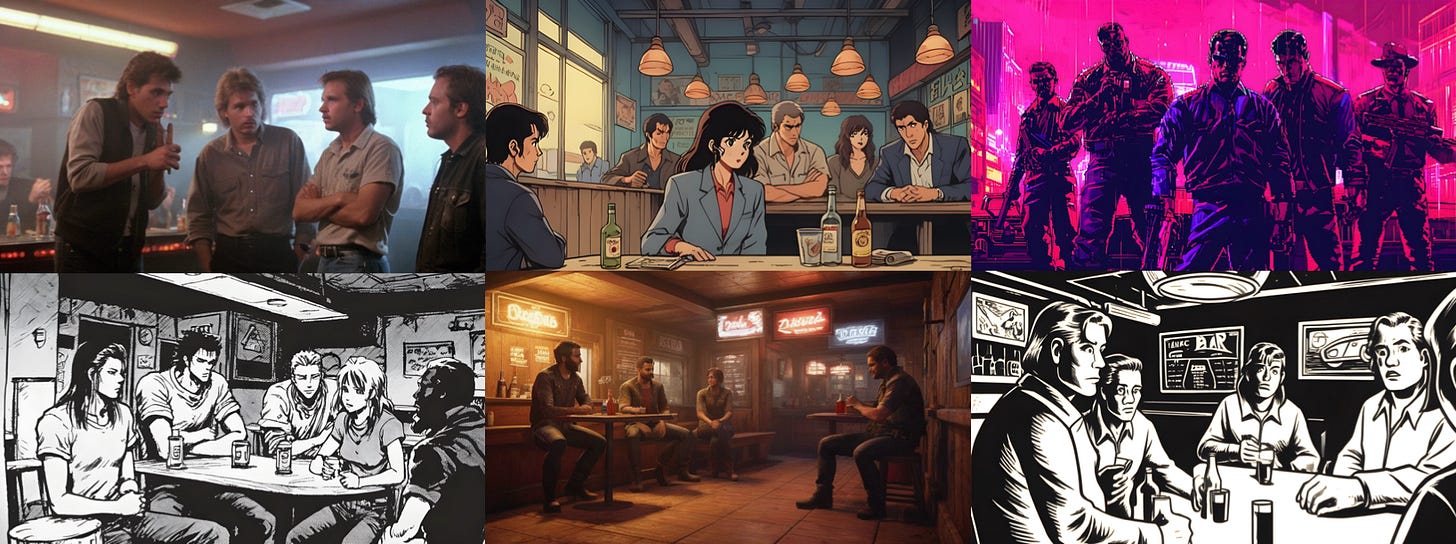Today, we release Lore Machine v2.3. The upgraded system is stacked with new features, including increased character and location consistency.
Watch 2.3 transform one story using six different style models, then build a storyscape, a manga and an animation.
All this style shifting provides a unique viewpoint on consistency. Consistency across multiple generative scenes is one of Lore Machine’s most crucial capabilities. Naturally, we spend a lot of time quantifying consistency. Normally we measure consistency by comparing sequential scenes in the same art style. We call this single-style persistence. By we can also compare a single scene’s composition across different styles. We call this multi-style persistence.
Perhaps a bird’s eye view is in order. Here are six storyboards rendered in six different art styles. The green arrows below indicate how we map single-style persistence; the pink arrows indicate how we map multi-style persistence.
By measuring multi-style persistence, we gain a valuable line of sight on the amount of impact a style model has on the content of a scene.
To measure multi-style persistence, we created a scoring matrix based on the parameters we regularly use for assessing single-style persistence. These include character phenotype, character count, clothing, environment, action, blocking, tone, time of day and weather.
By laying six scene iterations out side-by-side, we can then rate each parameter between 1 and 10 for a total multi-style persistence score of 100.
Let’s apply this methodology to score some scenes!
Scene 1
Here we have our female protagonist. We see consistency across hair length, hair color, ethnicity, eye color, slightly tense vibes, and time of day. We see medium deviation across age, clothing and action. We see noticeable deviation in character count and location.
Score: 68/100
Scene 2
OK, definitely nailed the ‘gang of street toughs in a warehouse’ brief. Vibe, blocking, and time of day are also on point. Character count and clothing is out the window.
Score: 71/100
Scene 3
Clothing, character, and time of day are dialed. Blocking and character count are a bit off. Location is all over the place.
Score: 66/10
Scene 4
Character count, vibe, blocking, airport hangar location…I mean come on! Clothing is off by a shade. Character action is an abject failure.
Score: 80/100
Scene 5
Location, action, blocking, character count and character consistency are not too shabby. Clothing is menh. Time of day nowhere.
Score: 69/100
Scene 6
What is UP character count, character attributes, vibe, and blocking! A couple close-but-not-quites on time of day and location. No total misses.
Score: 81/100
Scene 7
Don’t love the character count, but group of dive bar-goers gets my vote. Gender mix is a bit lopsided. Time of day is unwieldy.
Score: 82/100
Of course, this hard-edged scoring methodology must have some give. Generative storytelling is an art and a science after all.
Each style maintains its own proclivities, some of which are more welcome than others. The style models chosen for the above measurements are 1987 (retro film), Kanji (anime), DotMatrix (16-bit), RoboWolf (manga), MeshMode (video game throwback), and Lino/Slice (woodblock print). The clothing in a retro film should indeed contrast the sartorial inclinations of manga. The lighting in an early-2000s video game should indeed contrast the 16-bit style of a late-80s video game.
Stability could be adhered to so closely that we end up with uniformity. In this way, stylistic personality steers us clear of generative media’s dreaded same-ee ouputs. Sounds a lot more fun to us.
We started a Twitter account to get the word out about Lore Machine. If you’re feeling the vibes, give us a follow.
For more exhaustive reports from the intersection of style and content,










